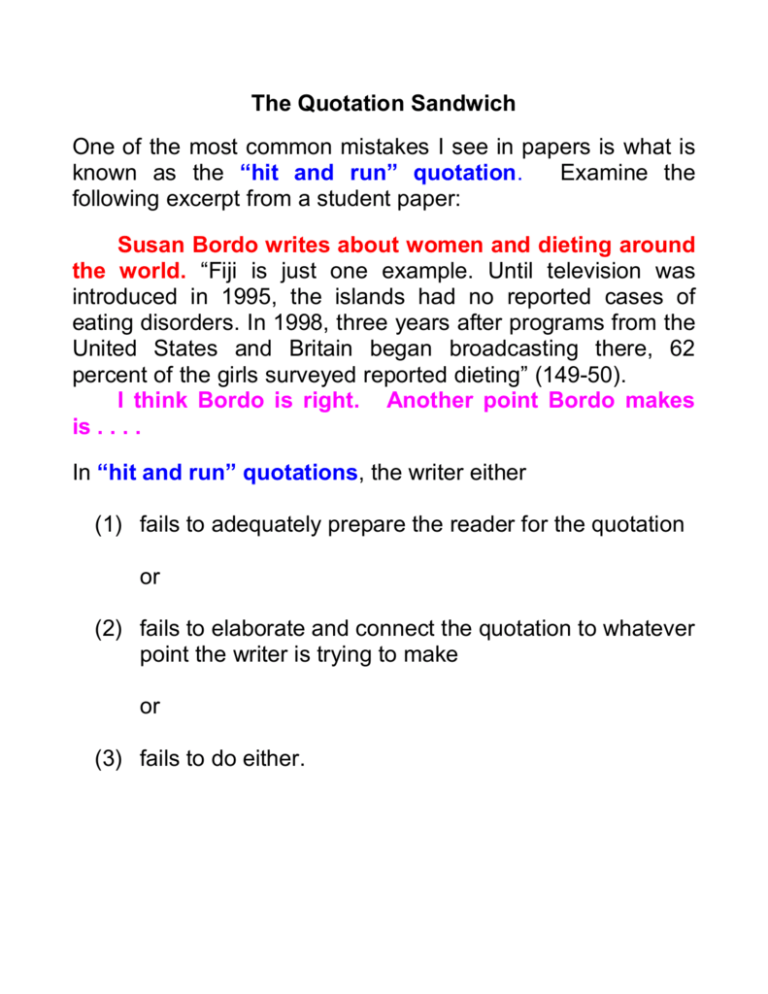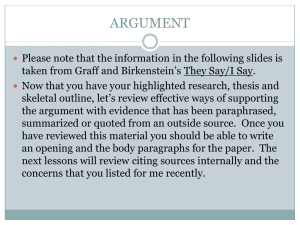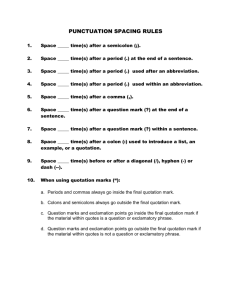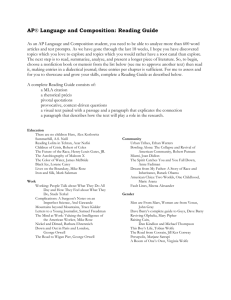QuotationSandwichWor..
advertisement

The Quotation Sandwich One of the most common mistakes I see in papers is what is known as the “hit and run” quotation. Examine the following excerpt from a student paper: Susan Bordo writes about women and dieting around the world. “Fiji is just one example. Until television was introduced in 1995, the islands had no reported cases of eating disorders. In 1998, three years after programs from the United States and Britain began broadcasting there, 62 percent of the girls surveyed reported dieting” (149-50). I think Bordo is right. Another point Bordo makes is . . . . In “hit and run” quotations, the writer either (1) fails to adequately prepare the reader for the quotation or (2) fails to elaborate and connect the quotation to whatever point the writer is trying to make or (3) fails to do either. Avoid “hit and run” quotations by utilizing the “quotation sandwich.” • The quotation sandwich begins with the top slice of bread where the writer provides the lead-in to the quotation. In the top slice, the writer typically (1) introduces who is speaking by identifying/ credentialing the source (e.g., renowned screenwriter Robert Towne) and (2) sets up the reader for the quotation. • The quotation itself is the meat of the sandwich. The trick here is to identify the best part of the quote and to only include the bare minimum. By so doing, you maximize the quotation's effectiveness. • The bottom slice of bread is the where you elaborate on the quotation by noting what you think it means and why it is important. Compare the previous quote with the addition of the top slice of the “quotation sandwich": The feminist philosopher Susan Bordo deplores the hold that the Western obsession with dieting has on women. Her basic argument is that increasing numbers of women across the globe are being taught to see themselves as fat and in need of a diet. Citing the island of Fiji as a case in point, Bordo notes that “until television was introduced in 1995, the islands had no reported cases of eating disorders. In 1998, three years after programs from the United States and Britain began broadcasting there, 62 percent of the girls surveyed reported dieting” (149-50). I think Bordo is right. Another point Bordo makes is . . . . In the top slice of the quotation sandwich notice how the writer (1) both introduces and credentials the author (feminist philosopher Susan Bordo), then goes on to (2) set up the quotation. Also notice how the writer has minimized the quote itself to maximize the impact of the meat of the sandwich. The feminist philosopher Susan Bordo deplores the hold that the Western obsession with dieting has on women. Her basic argument is that increasing numbers of women across the globe are being taught to see themselves as fat and in need of a diet. Citing the island of Fiji as a case in point, Bordo notes that “until television was introduced in 1995, the islands had no reported cases of eating disorders. In 1998, three years after programs from the United States and Britain began broadcasting there, 62 percent of the girls surveyed reported dieting” (149-50). I think Bordo is right. Another point Bordo makes is . . . . Also note how the “quotation sandwich” minimized the quotation by paraphrasing the first portion quoted in the “hit and run” quotation. By the way, did you also notice how the special case of introducing a quote in a sentence using the word “that” means that the first word in the quote begins with a small letter (“until”) even though it was the first word of the quoted sentence and would normally be capitalized? Finally, note how the bottom slice of the sandwich below elaborates upon the quotation by explaining what it means and why it is important. The feminist philosopher Susan Bordo deplores the hold that the Western obsession with dieting has on women. Her basic argument is that increasing numbers of women across the globe are being taught to see themselves as fat and in need of a diet. Citing the island of Fiji as a case in point, Bordo notes that “until television was introduced in 1995, the islands had no reported cases of eating disorders. In 1998, three years after programs from the United States and Britain began broadcasting there, 62 percent of the girls surveyed reported dieting” (149-50). Bordo's point is that the West's obsession with dieting is spreading even to remote places across the globe. Ultimately, Bordo complains, the culture of dieting will find you, regardless of where you live. Bordo's observations ring true to me because a friend of mine from a remote area in China speaks of the cult of dieting among young women there . . . . The bottom slice of the quotation sandwich is what is generally missing in student papers. Yet, it is critical. This is where you elaborate on what the quotation means and why it is important. Do not assume that the quotation is self-explanatory. Not all of your quotes will be quotation sandwiches; however, you should always consider the quotation sandwich for every quote in your paper.









